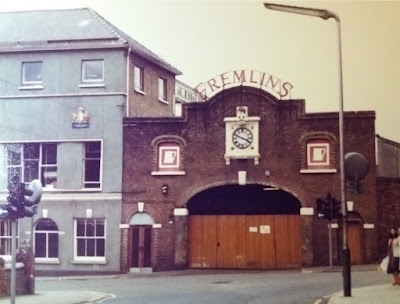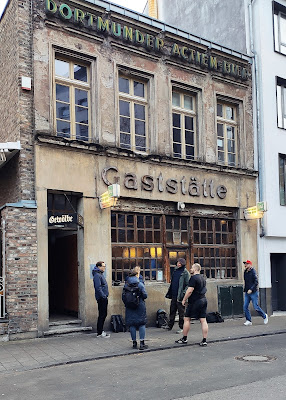There’s a fair amount of brewing history associated with Wateringbury, although nowadays, very little remains of this heritage. Yet, up until the mid-1980s, national brewer Whitbread had a substantial plant in the village, on a site overlooking the Medway. This rather attractive, and typical 19th Century, tower brewery, was known as the Phoenix Brewery, and was home to Frederick Leney & Sons. Whitbread acquired the business as well as the site in 1927, as part of their initial expansion from their London home but Wateringbury continued brewing Leney’s ales for local pubs, until 1961 when the licensed premises were sold to Fremlin’s of Maidstone. The latter company joined the Whitbread group in 1967 and the day-to-day running of the Wateringbury brewery was then integrated into their Maidstone operation. Until fairly recently you could sometimes see the name of Frederick Leney etched into the windows of local pubs. The other Wateringbury brewery was that of Jude, Hanbury & Co Ltd, who moved to Canterbury in 1924 after acquiring the business of Ash & Co. Their brewery in Bow Road, was sold to the Yalding Soap Co. and was later demolished. Production at the Phoenix Brewery, was then switched to brewing mainly bottled beers for the Whitbread group. Before its closure in 1984, beers such as light ale, and Gold Label barley wine were brewed at Wateringbury, although it’s interesting to note that this famed barley wine, started life as a Sheffield beer. Developed originally by Tennant's in 1951, it was a pale-coloured, sparkling barley wine of great strength, containing around 10.6% alcohol. Its golden colour was unusual, because the vast majority of high strength beers tended to be on the dark side, including Whitbread’s own Final Selection barley wine. The latter brew was replaced by Gold Label, which ended up being brewed elsewhere within the group, when Wateringbury ceased production. I’m assuming the beer is still available, although the advertising slogan used to sell it, “Strong as a double Scotch, less than half the price,” has long disappeared. Following closure, the attractive brewery buildings at Wateringbury were pulled down, and all that remains of this once thriving local enterprise is the Phoenix weather-vane atop of the nearby Wateringbury Hotel, which although now owned by Greene King, operates under the Chef & Brewer banner along with the adjoining Premier Inn. There’s a bit of family history here, because the youngest of my two sisters, bought one of the houses on the former Phoenix site, and lived there for a while with her family, during the mid-90’s. Of slightly more interest, as well as relevance, is the story that a friend and I hopped over the fence, one weekend, whilst demolition of the brewery was in its initial stages. Despite the fact we were trespassing, and that parts of the site were potentially unsafe, we had a good look around. My friend ended up with a World War II ARP, steel helmet and I uncovered an old wooden beer crate. As is often the case when enterprises are closed down, a lot of seemingly worthless objects are just abandoned. Potentially there might have items, such as brewing logs, which would have been of interest to brewery historians, although somehow apart from my friend’s steel helmet, I don’t think there was much else of value remaining on the site. In common with many other towns and villages, Wateringbury would at one time, have been well supplied with public houses, especially as it was a settlement with two thriving breweries. Sadly, nearly all of them have disappeared, either having been converted either for residential use, or demolished altogether. One such remaining survivor is the Railway, a white-painted late 19th Century pub at the bottom of the hill, opposite Wateringbury station. The pub is almost in the neighbouring village of Nettlestead, but that’s one for the pedants. From memory, I’d only made one previous visit to the Railway, and that was around 20 years ago, at the end of one of Maidstone CAMRA’s, annual Good Friday rambles. As is often the case over Easter, that particular Good Friday was characterised by freezing cold conditions, and it might even have snowed. A friend and I dived into the Railway, whilst waiting for our train back to Tonbridge, and whilst I remember precious little from that visit, the pub certainly provided a warm and very welcome respite from the Arctic conditions outside. And there, the story might have ended, if Matthew hadn’t noticed a social media post about the Railway. He discovered that on Saturday mornings, the Railway offers a buffet breakfast, of the “all you can eat” variety. The reason for the breakfast offer taking place on a Saturday, is because the Railway majors on roast dinners on Sundays with a carvery that is very popular with the punters. Consequently, keeping the two meal occasions separate, makes a lot of sense for the pub management. Consequently, the pair of us pitched up just after 9am, and after leaving the car in the free (TMBC please take note) car park, at the top of the village, probably on the site of the former Jude Hanbury brewery, we walked down to towards the river, and the Railway public house. After walking into the pub, we informed the lady behind the bar that we’d come to enjoy the breakfast offering, and after showing us to an empty table in the dining area, we were asked how would we like our eggs cooked. Eggs were the only things on the buffet menu that were cooked to order, the rest of the breakfast items being on a “help yourself” basis. A hot water urn was available for teas and coffees, with the hot drinks also being self-service. There was a good selection of typical breakfast goodies, such as bacon (back cuts, rather than streaky), sausages, tomatoes, beans, fried bread, hash browns etc, plus bread for toasting. All in all, a good choice of traditional breakfast fayre, and if you wanted to, you could return to the hot serving dishes, for seconds. A number of other customers turned up whist we were there, and it was obvious from the interaction between them and the staff, that they were regulars. As for the breakfast itself, the cost worked out at a very reasonable, £9.50 per head. If I’m honest, there was a touch of the “greasy spoon” about the presentation, but in mitigation the bacon, eggs and sausages were good quality, and definitely not your typical “cash & carry” catering option. Once I’d finished my breakfast, a visit to the gents provided an excuse for a look around the rest of the pub. There is a large pool table to the right of the bar, but apart from that, nothing jumped out as unusual. In short, the Railway comes across as a basic, and down to earth local, catering to its own band of loyal regulars, many of whom seemed gave the appearance of ex-pat Londoners. This is not uncommon in this part of rural Kent, with many people having been acquainted with the county as itinerant fruit pickers and people whose parents or grandparents, came down to Kent in order to assist with the annual hop harvest. Before walking back to the car, we crossed the road, and the railway, and took a look at the river. There, we noticed a café, in the form of the Riverside Restaurant, which seems worthy of further investigation. A boatyard, plus marina on the opposite bank of the Medway, is proof of the popularity of boating on this section of Kent’s largest river. I’m looking forward to seeing more of the riverside, at first hand, when I undertake my planned walk along the banks of the Medway, later in the year, and I shall also be on the look out for further breakfast opportunities, “greasy spoon” or otherwise!















































